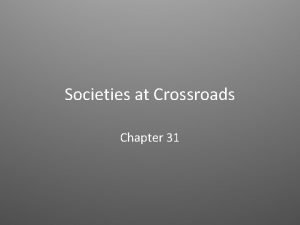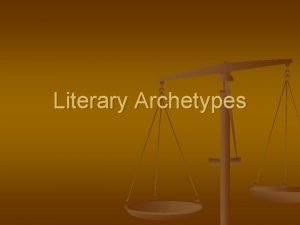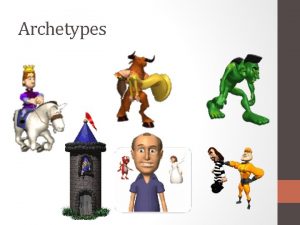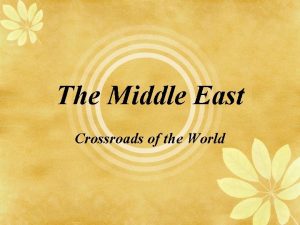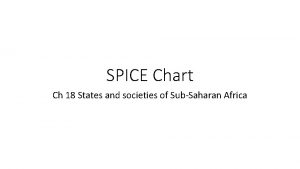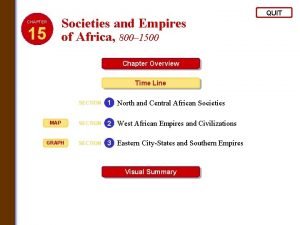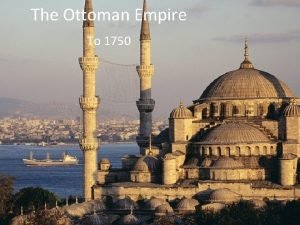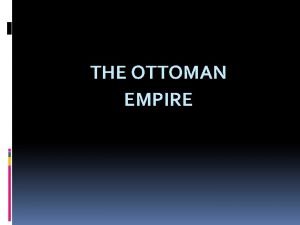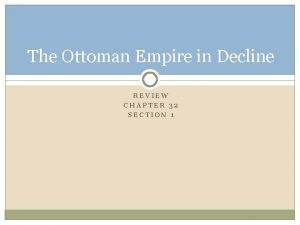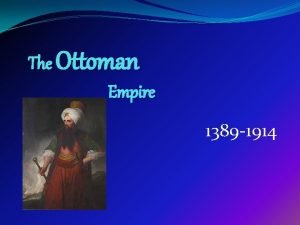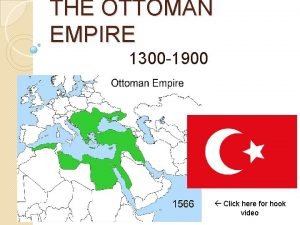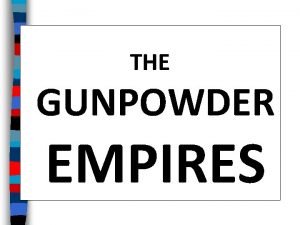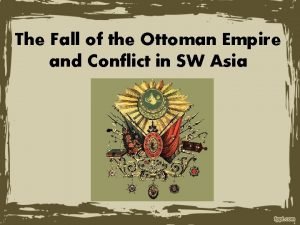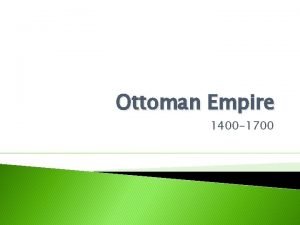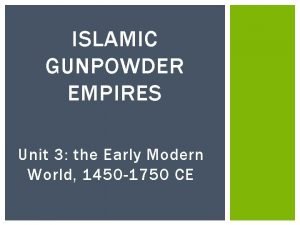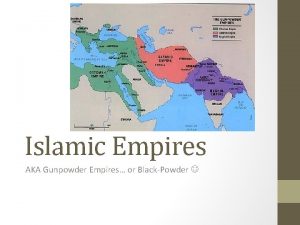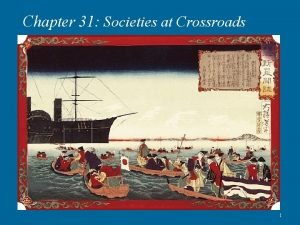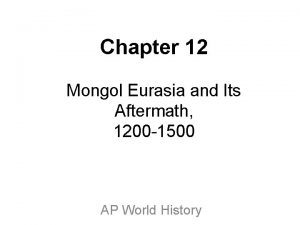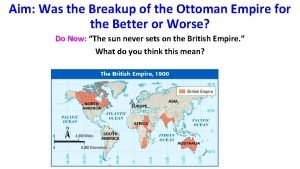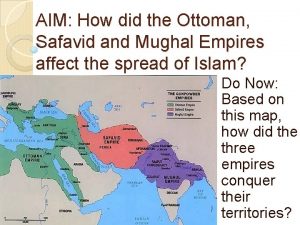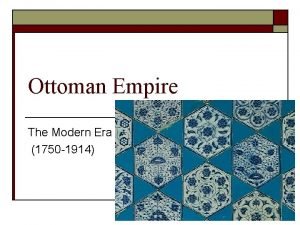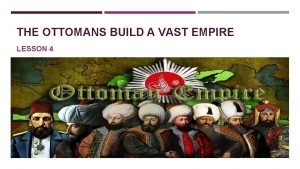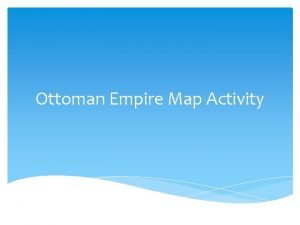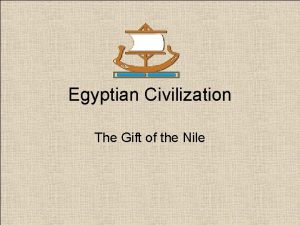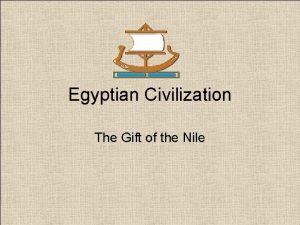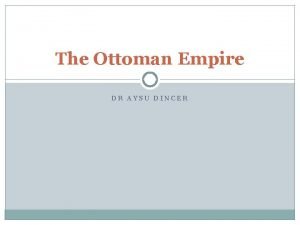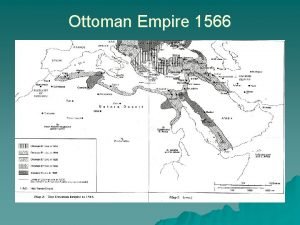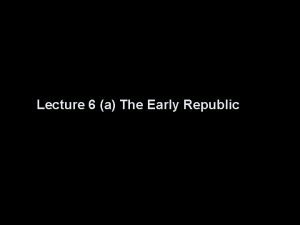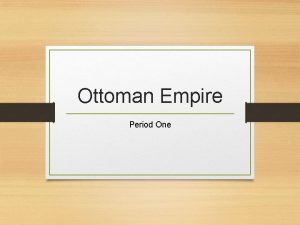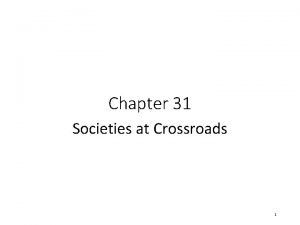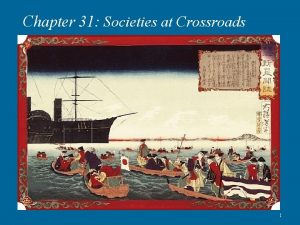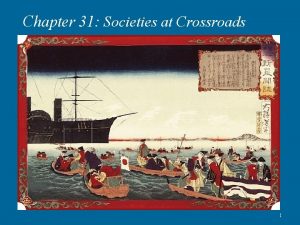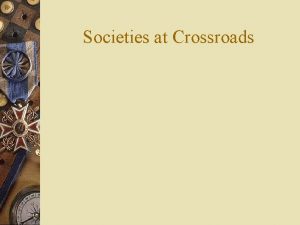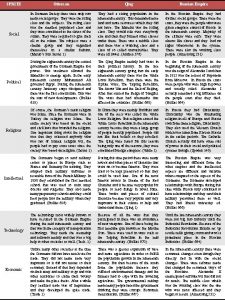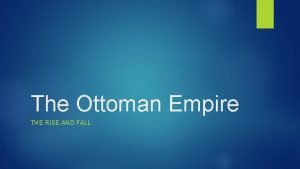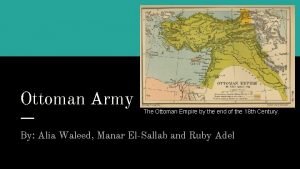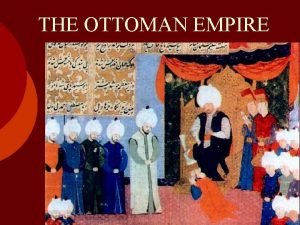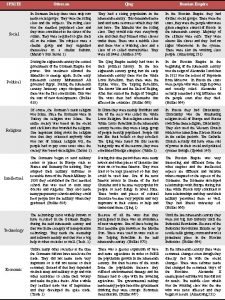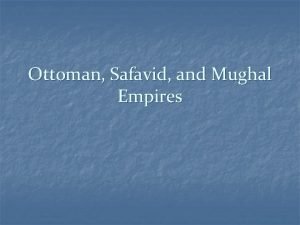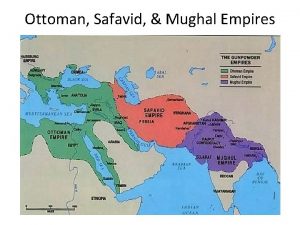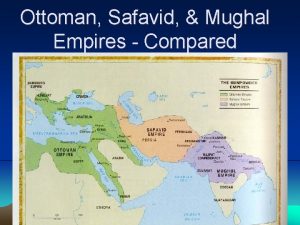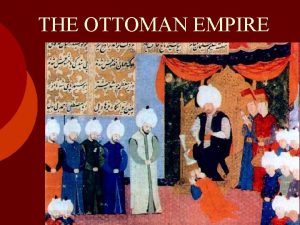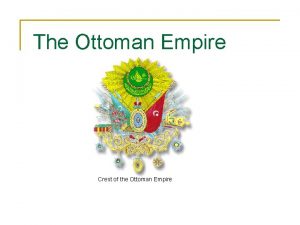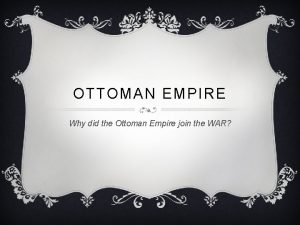Chapter 31 Societies at Crossroads 1 The Ottoman





















































- Slides: 53

Chapter 31: Societies at Crossroads 1

The Ottoman Empire in Decline Height of Ottoman military expansion in late seventeenth century 2

The Ottoman Empire in Decline n n At its height in the 1600 s, the Ottoman Empire had 29 provinces and several tributary states. Provinces Become More Independent: Semi-independent local warlords use mercenaries and slave armies to support sultan in return for imperial favor. Central Government Receives Less Revenue: Many local administrators carry out massive corruption, misusing tax revenues. Central government becomes less effective. Defeats in War: In the 1700 s and 1800 s, territorial holdings are gradually diminished through many defeat in wars. 3

The Ottoman Empire in Decline n The Austrians, Russians, and British, among others, beat the Ottomans in many different wars largely due to European advances in technology and strategy. q q q Russo-Turkish Wars (1735 -1739; 1768 -1774; 1787 -1792; 1806– 1812; 1828– 1829; 1877– 1878) Austro-Turkish Wars (1716– 1718; 1787– 1791) Crimean War (1853 -1856): Conflict between Russian Empire against the French, British, and Ottomans. 4

The Ottoman Empire in Decline n The elite Janissary corps, the best Ottoman soldiers, become corrupt and less fearsome warriors. They become more interested in palace intrigue than fighting wars. British painting of a Janissary in the early 19 th century 5

The Ottoman Empire in Decline Portrait of Muhammad Ali in 1840 n n Napoleon’s unsuccessful invasion of Egypt (1798 -1801) triggers local revolt against Mamluks/Ottomans under Muhammad Ali (r. 1805 -1848) q Muhammad Ali fights two wars against the Ottomans (18311833 and 1839 -1841) q Nominally subordinate to Sultan, but�threatened the capture of Istanbul in 1839 British support Ottomans only to avoid possible Russian expansion 6

The Ottoman Empire in Decline n Nationalist uprisings drive Ottomans out of Balkans q q n Greek War of Independence (1821 -1832) Serbia revolts from 1804 -1817 and gains some autonomy Russo-Turkish War of 1877 -1878 q q q Kingdom of Romania gains full independence Bulgaria gains full indepence Serbia gains full independence 7

Territorial Losses of the Ottoman Empire, 1800 -1923 8

Ottoman Economy n n Imports of cheap manufactured goods place stress on local artisans; urban riots result. Export-dependent Ottoman economy increasingly relies on foreign loans q q Exports: raw cotton, grains, tobacco, wool, hides Slave-produced commodities from New World are cheaper, undercutting products of the Ottoman empire 9

Ottoman Economy n n By 1882 Ottomans unable to pay even interest on loans, forced to accept foreign administration of debts (took out their first foreign loans in 1854, just as the Crimean War was starting). Capitulations: agreements that exempted Europeans from Ottoman law q q Extraterritoriality gives tax-free status to foreign banks and businesses Foreign merchants begin to dominate overseas trade 10

Early Reforms n 1800 s: Attempts to reform taxation, increase agricultural output, and reduce corruption q q n Sultan Selim III (r. 1789 -1807) remodeled army on European lines Janissaries revolt in 1807 and kill the new troops, imprison Selim III Sultan Mahmud II (r. 1808 -1839) q q q Massacres and disbands Janissaries in 1826, and creates fully modern army Creates imperial postal service in 1834 Rebuilt Ottoman navy 11

Tanzimat (“Reorganization”) Era, 1839 -1876 n n Abdülmecid I (r. 1839 -1861), promotes a new, western-oriented reform program called “Tanzimat. ” Drafted new law codes that strengthened civil rights for minorities to appease rebellious nationalist groups (Albanian, Bulgarian, Romanian, Serbian, Armenian, etc. ) 12

Tanzimat (“Reorganization”) Era, 1839 -1876 n n n n Abdülmecid introduced paper bank notes (1840) Proclaimed a national anthem and flag (1844) Replaces turban with fez as official male headgear Established first modern universities and academies (1848) Gets rid of higher taxes on non-Muslims (1856) Undermined power of traditional religious elite Tries to rein in corruption in government 13

Tanzimat (“Reorganization”) Era, 1839 -1876 n n The reforms were fiercely resisted by the religious conservative establishment and entrenched bureaucracy Also drew opposition from radical Young Ottomans, secret group of intellectuals founded in 1865, who were influenced by Enlightenment ideas and wanted a constitutional monarchy 14

The Young Ottoman Takeover of 1876 n Young Ottomans stage a coup in 1876 and install Abdül Hamid II as Sultan (r. 1876 -1909) q q Constitution adopted Representative government: Parliament with members of Senate elected by the Sultan and members of Chamber of Deputies elected by the people 15

The Young Ottoman Takeover of 1876 n Abdul Hamid II suspends the constitution by 1878 under emergency conditions (war with Russia) q q q Takes back power through brutal repression Imprisons and executes many radicals Many reformers go into exile in Europe 16

The Young Turks n Ottoman Society for Union and Progress q q Founded by medical students in exile in Paris in 1889, with many non-Turkish members; wanted to reinstitute 1876 constitution Called for rapid, secular reforms “Congress of Ottoman Opposition in Paris in 1902: Started to be called “Young Turks” instead of “Young Ottomans” Young Turks force Abdül Hamid II to restore parliament in 1908, and then dethrone him in favor of Mehmed V Rashid (r. 1909 -1918). 17

Young Turk Rule n n Replaced “Ottomanism”—legal encouragement of many nations living together—with Turkish nationalism Attempted to establish Turkish hegemony over far -flung empire q n Turkish made official language, despite large numbers of Arabic and Slavic language speakers Yet could not contain forces of decline 18

The Russian Empire Under Pressure n Russia a massive, multi-cultural empire q n n n Only approximately half speak Russian and observe Russian Orthodox Christianity Romanov tsars rule in a highly autocratic fashion Powerful class of nobles exempt from taxation and military duty Nobility benefit from an exploitative serfdom; serfdom had declined in Western Europe by the 1400 s, but persists in Russia 19

The Russian Empire, 1801 -1914 20

The Crimean War, 1853 -1856 n n Russians expand into Caucasus in larger attempt to establish control over weakening Ottoman Empire Threatens to upset balance of power; British and French Empires intervene to help Ottomans Russia driven back from Crimea in humiliating defeat Demonstration of Russian weakness in the face of western technology and modern strategy 21

Reform: Emancipation of the Serfs n n Serfdom source of rural instability and peasant revolt in the wake of the Crimean War loss Tsar Alexander II emancipates serfs in 1861, without alleviating poverty, land hunger q n Forced to pay for lands they had farmed for generations Limited attempts to reform administration, small-scale representative government q Network of elected district assemblies called zemstvos 22

Industrialization in Russia n Witte System q q q Count Sergei Witte (1849 -1915), serves as minister of finance, 1892 -1903 Oversaw construction of Trans-Siberian railroad (started in 1891; completed in 1916) Oversaw State-Sponsored Industrialization Ø Ø Peasants uprooted from rural lifestyle and pushed into factories to work for low wages, long hours Led to massive discontent 23

Repression n Intelligentsia class spreads radical ideas for social change q q Socialists, anarchists Terror tactics, assassinations Attempt to connect with the mistrustful peasantry in 1870 s, who often denounce them Many of the intelligentsia sent into Siberian exile 24

Repression n Tsarist authorities turn to censorship, secret police Nationalist sentiment seething in Baltic provinces, Poland, Ukraine, Georgia, and central Asia Period of upheaval contributes to great literature q Fyodor Dostoyevsky (1821 -1881) q Leo Tolstoy (1828 -1910) q Anton Chekhov (1860 -1904) q Ivan Turgenev (1818 -1883) 25

Radicalization n Radical anarchist group, the People’s Will movement (“Narodnaya Volya), assassinates Tsar Alexander II in 1881 q q Previous attempts on his life: one in 1866 and two in 1879, and one in 1880; People’s Will tried to blow up his train and set off a charge in the Winter Palace Bullet-proof carriage protects emperor from first blast, but gets out and a second bomb is thrown at him, killing him Prompted widespread pogrom attacks on Jews Assassination leads to repression under the grim Alexander III (r. 1881 -1894), who relied heavily on the Okhrana (secret police) to crack down on radicals. 26

Radicalization n n Nicholas II (r. 1894 -1917): Weak and vacillating tsar enters into war with Japan (1904 -1905) Humiliating defeat exposes government weaknesses Social discontent boils over in Revolution of 1905; revolt fails, but triggers massive discontent Workers’ strikes force government to make political concessions, like the creation of a national representative body, the Duma 27

Qing Empire: Chinese Restrictions on European Trade Since 1759, European commercial presence limited to port of Guangzhou (the British called it Canton) 28

Chinese Restrictions on European Trade n n n Foreign merchants forced to deal solely with a small group of licensed Chinese firms called cohongs who only accepted one currency of trade: silver bullion Not much Chinese demand for European goods British East India Company heavily involved in opium trade q Opium grown in India, sold in China for silver, silver used to buy other Chinese products 29

The Opium Trade The Opium Plant British East Indiaman at port © 2011, The Mc. Graw-Hill Companies, Inc. All Rights Reserved. 30

The Opium Trade n n n Portuguese first bring opium to China in 1600 s Practice of mixing it with tobacco begins in mid-1600 s 1729: Emperor outlaws sale of opium, but the law is poorly enforced Practice of smoking plain opium evolves by late 1700 s British East India company’s expansion in India leads in later 1700 s leads to larger volume of opium sold into China Increasing trade and social ills evident by late 1830 s 31

The Opium Trade n n Chinese move to enforce ban in 1830 s under Chinese official, Lin Zexu (1785 -1850) British agents engage in military retaliation in the First Opium War (1839 -1842) British naval forces easily defeat Chinese with superior technology Hong Kong ceded to British in Treaty of Nanjing (1842) and five ports are opened to British traders 32

The Opium Trade Steam-driven warship Nemesis destroys Chinese junks in 1841 33

Unequal Treaties n n Second Opium War (1856 -1860): British and French attack Chinese since China resists opening more ports and legalizing opium importation China forced into a series of disadvantageous treaties known as “Unequal Treaties” Extraterritorial legal status granted to British subjects Later other European countries conclude similar treaties 34

East Asia in the Nineteenth Century 35

The Taiping Rebellion (1850 -1864) n n n Large-scale rebellions in later nineteenth century reflect poverty, discontent of Chinese peasantry Population rises 50% between 1800 -1900, but land under cultivation remains static, leading to frequent famine Nian rebellion (1851 -1868), Muslim rebellion (1855 -1873), Tungan rebellion (1862 -1878) 36

The Taiping Rebellion (1850 -1864) n n n The Taiping rebellion was led by Hong Xiuquan (18141864), a schoolteacher who called for destruction of Qing dynasty Hong declared himself the brother of Jesus Christ By 1850, he had between 10, 000 to 30, 000 followers, alarming the authorities 37

Taiping Platform n n n Abolition of private property Creation of communal wealth Prohibition of foot binding, concubines Free public education, simplification of written Chinese, mass literacy Prohibition of sexual relations among followers (including married couples) q Yet leaders maintained harems 38

Taiping Defeat n n Taipings captured Nanjing in 1858 and make it their capital Attack on Beijing with force of 1 million, but turned back Imperial army unable to contain Taipings, so regional armies created with Manchu soldiers and outfitted with European weaponry Hong commits suicide in 1864; Nanjing recaptured q 100, 000 Taipings massacred 39

The Self-Strengthening Movement (1860 -1895) n n n High point is in 1860 s-1870 s Slogan “Chinese learning at the base, Western learning for use” Blend of Chinese cultural traditions with European industrial technology q Building of shipyards, railroads, academies Ultimately changes to Chinese economy and society were superficial Empress Dowager Cixi (1835 -1908) nominally supports technological development of the movement, but is suspicious of Western ideologies 40

Empress Dowager Cixi n n n Cixi (1835 -1908) unofficially rules China from 1861 to 1908; two emperors are essentially her puppets (her son, then nephew) Supposedly diverted government funds for her own aesthetic purposes, according to rumors Was in general xenophobic and conservative; foremost concern was protecting the dynasty 41

Spheres of Influence n Qing dynasty loses influence in southeast Asia, losing tributary states to Europeans and Japanese q q q n Vietnam: Lost to France in 1886 Burma: Lost to Great Britain in 1885 Korea, Taiwan, Liaodong Peninsula: Lost to Japan as a result of the Sino-Japanese War of 1895 China itself divided into spheres of influence by European powers in 1895 42

Spheres of Influence 1898 French political cartoon Empress Dowager Cix 43

Hundred Days Reforms (1898) n n n Kang Youwei (1858 -1927) and Liang Qichao (1873 -1929): Two popular scholars and journalists who start a reform movement. Interpreted Confucianism to allow for Western-style changes to system: wanted to make China a constitutional monarchy Favored rapid industrialization through capitalists means Emperor Guangxu (r. 1875 -1908) attempts to implement reforms Empress dowager Cixi nullifies reforms and imprisons the emperor, her nephew 44

The Boxer Rebellion (1898 -1901) n n n Cixi supports Society of Righteous and Harmonious Fists (“Boxers”), an anti-foreign and anti-Christian militia 1899 fought to rid China of “foreign devils” Misled to believe European weapons would not harm them, 140, 000 Boxers besiege European embassies in 1900 Crushed by coalition of European forces: Russia, Britain, France, U. S. , Japan, Germany, Austro-Hungary & Italy Brutal repression of Boxers by Western forces; China forced to accept stationing of foreign troops on her soil 45

Death of the Dowager Empress n n n Emperor Guangxu dies a mysterious, sudden death on November 14, 1908 at age 33; later discovered to be arsenic poisonng Cixi dies one day later She places two-year-old Puyi placed on the throne before dying Revolution in 1911: Main goal was to replace Manchu government with a Han one. First president of new republic is Dr. Sun Yat-sen (1866 -1925) Puyi abdicates in 1912; film The Last Emperor tells of his life. He dies on 1967. 46

Transformation of Japan Emperor Meiji (r. 1867 -1912) 47

Transformation of Japan n Japanese society is in turmoil in early nineteenth century q q n Poor agricultural output, famines, high taxes Daimyo and samurai classes decline, peasants starving Tokugawa government attempts reforms, 1841 -1843 q q Cancelled daimyo and samurai debts Abolished merchant guilds Compelled peasants to return to cultivating rice These reforms ultimately ineffective 48

Foreign Pressure n n n Europeans and Americans attempt to establish relations in 1840 s; country is closed Japan only allowed Dutch presence in Nagasaki U. S. in particular was looking for a Far East Pacific ports for whalers and merchants In 1853 Commodore Matthew Perry sails gunships into Edo harbor (Tokyo) and forces Japanese to open port Perry’s black-hulled steam warship makes an impression Sparks conservative Japanese reaction against shogun, rally around emperor in Kyoto 49

Foreign Pressure Images of Perry and his ship 50

The Meiji Restoration (1868) n n n Mutsuhito takes throne in 1867 as figurehead Brief civil war between imperial and Tokugawa forces in 1867 -68; shogun’s forces are defeated 1868: With the shogun gone, Emperor Mutsuhito (Meiji, 1852 -1912) takes full power; changes name of Edo to Tokyo Goals of prosperity and strength: “rich country, strong army” Resolves to learn western technology © 2011, The Mc. Graw-Hill Companies, Inc. All Rights Reserved. 51

Meiji Reforms n Travelers Fukuzawa Yukichi (1835 -1901) and Ito Hirobumi (1841 -1909) travel to U. S. , Europe q n Meiji government removes privileges for daimyo and samurai q q n Argue for adoption of western legal proceedings, technology Conscript army replaces samurai mercenaries Samurai rebellion crushed by national army Tax reform: payment in cash, not kind (grain) © 2011, The Mc. Graw-Hill Companies, Inc. All Rights Reserved. 52

Constitutional Government n n n 1889 constitution promulgated Conservative: only 5 % of male population allowed to vote in 1890 election Economic reforms to promote rapid industrialization Dramatic improvement in literacy rates Government holdings sold to private investors: zaibatsu financial cliques develop © 2011, The Mc. Graw-Hill Companies, Inc. All Rights Reserved. 53
 Chapter 31 societies at crossroads outline
Chapter 31 societies at crossroads outline Chapter 26 civilizations in crisis the ottoman empire
Chapter 26 civilizations in crisis the ottoman empire Underground railroad quilt codes
Underground railroad quilt codes The crossroads archetype examples
The crossroads archetype examples Threshold guardian examples
Threshold guardian examples Crossroads archetype examples
Crossroads archetype examples Non examples of archetype
Non examples of archetype Why do geographers call arabia a crossroads location
Why do geographers call arabia a crossroads location Middle east crossroads of the world
Middle east crossroads of the world On which side of the window are you
On which side of the window are you Crossroads bank for social security
Crossroads bank for social security Dr rick griffith
Dr rick griffith Cat countable or uncountable
Cat countable or uncountable Crossroads international church singapore
Crossroads international church singapore Crossroads hotel lilongwe
Crossroads hotel lilongwe Ethiopia spice chart
Ethiopia spice chart Chapter 15 societies and empires of africa
Chapter 15 societies and empires of africa Ottoman empire 1750
Ottoman empire 1750 The ottoman empire grew and expanded after it conquered the
The ottoman empire grew and expanded after it conquered the Map of ottoman empire 1800
Map of ottoman empire 1800 Was the ottoman empire tolerant of other religions
Was the ottoman empire tolerant of other religions Ottoman empire 1900
Ottoman empire 1900 Ottoman empire at its height
Ottoman empire at its height Ottoman empire 1914
Ottoman empire 1914 Ottoman empire 1400
Ottoman empire 1400 Ottoman safavid and mughal empire map
Ottoman safavid and mughal empire map Ottoman architecture characteristics
Ottoman architecture characteristics How big was the islamic empire
How big was the islamic empire Ottoman safavid and mughal empire map
Ottoman safavid and mughal empire map How did the ottoman safavid and mughal empires arise
How did the ottoman safavid and mughal empires arise Map of ottoman empire 1800
Map of ottoman empire 1800 Ottoman empire gunpowder
Ottoman empire gunpowder Breakup of ottoman empire
Breakup of ottoman empire Shiism
Shiism Ottoman empire
Ottoman empire Ottoman empire 1914
Ottoman empire 1914 Who established ottoman empire
Who established ottoman empire Ottoman empire ducksters
Ottoman empire ducksters Ottoman empire map activity
Ottoman empire map activity Ottoman, safavid, and mughal empires venn diagram
Ottoman, safavid, and mughal empires venn diagram Ottoman tolerance
Ottoman tolerance Ottoman
Ottoman Ottoman
Ottoman China ottoman cap
China ottoman cap Special organization
Special organization Ottoman empire vocabulary
Ottoman empire vocabulary Ottoman empire balkan
Ottoman empire balkan Ottoman empire 1566
Ottoman empire 1566 Ali hada bara
Ali hada bara Suleiman the magnificent expansion
Suleiman the magnificent expansion What are the key achievements from the islamic golden age
What are the key achievements from the islamic golden age Hát kết hợp bộ gõ cơ thể
Hát kết hợp bộ gõ cơ thể Bổ thể
Bổ thể
